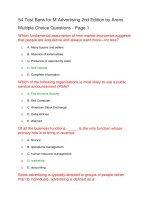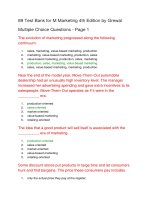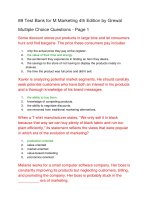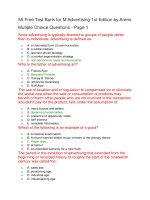Test bank for college physics 9th edition by young
Bạn đang xem bản rút gọn của tài liệu. Xem và tải ngay bản đầy đủ của tài liệu tại đây (171.2 KB, 7 trang )
Chapter 1 Models, Measurements and Vectors
Multiple Choice Questions
1) The following conversion equivalents are given:
1 gal = 231 in3
1 ft = 12 in
1 min = 60 s
A pipe delivers water at the rate of 95 gal/min. The rate in ft3 /s, is closest to:
A) 0.21
B) 0.19
C) 0.17
D) 0.15
E) 0.14
Answer: A
Var: 50+
2) The following conversion equivalents are given:
1 m = 100 cm
1 in = 2.54 cm
1 ft = 12 in
3.
A bin has a volume of 1.5 m The volume of the bin, in ft3 , is closest to:
A) 35
B) 41
C) 47
D) 53
E) 59
Answer: D
Var: 1
3) The following conversion equivalents are given:
1 mile = 5280 ft 1 ft = 12 in 1 m = 39.37 in
1 hour = 60 min 1 min = 60 s
A particle has a velocity of 4.7 miles per hour. The velocity, in m/s, is closest to:
A) 2.1
B) 1.7
C) 1.9
D) 2.3
E) 2.5
Answer: A
Var: 50+
4) A speed of 65 miles per hour is the same as
A) 24 m/s
B) 29 m/s
C) 32 m/s
D) 37 m/s
E) 42 m/s
Answer: B
Var: 1
5) The following conversion equivalents are given:
1 kg = 1000g
1 l = 1000 cm3 1 l = 0.0353 ft3
The density of a liquid is 0.83 g/cm3 . The density of the liquid, in kg/ft3 , is closest to:
A) 24
B) 19
C) 21
D) 26
E) 28
Answer: A
Var: 50+
6) A weight lifter can bench press 0.27 kg. How many milligrams (mg) is this?
A) 2.7 × 108 mg
B) 2.7 × 109 mg
C) 2.7 × 107 mg
D) 2.7 × 106 mg
Answer: A
Var: 50+
7) Your car gets 34.7 mi/gal on a trip. How many kilometers/liter did it get? (3.79 = 1 gal; 1 mi
= 1.61 km)
A) 14.7 km/l
B) 9.16 km/l
C) 55.9 km/l
D) 32.4 km/l
Answer: A
Var: 50+
Copyright © 2012 Pearson Education, Inc.
1
Chapter 1 Models, Measurements and Vectors
8) The wavelength of a certain laser is 0.66 microns, where 1 micron = 1 × 10-6 m. What is this
wavelength in nanometers? (1 nm = 10-9 m)
A) 6.6 × 102 nm
B) 6.6 × 103 nm
C) 6.6 × 101 nm
D) 6.6 × 104 nm
Answer: A
Var: 50+
9) Add 1299 g and 45.1 kg and express your answer in milligrams (mg).
A) 4.64 × 107 mg
B) 4.64 × 104 mg
C) 4.64 × 105 mg
D) 4.64 × 106 mg
Answer: A
Var: 50+
10) Express [2.2 × 106 ]-1/2 in scientific notation.
A) 6.7 × 10-4
B) 1.5 × 103
C) 1.5 × 10-5
D) 1.5 × 104
Answer: A
Var: 40
11) What is
0.405
to the proper number of significant figures?
0.76
A) 0.53
B) 0.533
C) 0.5329
D) 0.5
Answer: A
Var: 50+
12) What is 0.3272/3, to the proper number of significant figures?
A) 0.475
B) 0.47
C) 0.5
D) 0.4746
Answer: A
Var: 50+
13) Which of the following is a reasonable estimate of the number of characters (typed letters or
numbers) in a 609 page book? Assume an average of 194 words/page and a reasonable
average number of letters/word.
A) 5 × 105 char
B) 5 × 107 char
C) 5 × 106 char
D) 5 × 104 char
Answer: A
Var: 50+
14) A marathon is 26 mi and 385 yd long. Estimate how many strides would be required to run
a marathon. Assume a reasonable value for the average number of feet/stride.
A) 4.5 × 104 strides
B) 4.5 × 103 strides
C) 4.5 × 105 strides
D) 4.5 × 106 strides
Answer: A
Var: 1
15) Estimate the number of times an average personʹs heart beats in a lifetime. Assume the
average heart rate is 69 beats/min and a life span of 75 yr.
A) 3 × 109 beats
B) 3 × 108 beats
C) 3 × 1010 beats
D) 3 × 107 beats
Answer: A
Var: 50+
2
Copyright © 2012 Pearson Education, Inc.
Chapter 1 Models, Measurements and Vectors
16) The components of vector A are given as follows:
Ax = +7.6
Ay = -6.4
The magnitude of A is closest to:
A) 9.9
B) 7.9
C) 8.9
D) 11
E) 12
Answer: A
Var: 50+
17) The components of vector A are given as follows:
Ax = +6.1
Ay = -8.6
The angle measured counterclockwise from the x-axis to vector A , in degrees, is closest to:
A) 305
B) 125
C) 215
D) 145
E) 55
Answer: A
Var: 50+
18) The components of vectors A and B are given as follows:
Ax = +7.6
Ay = -9.2
Bx = -5.1
By = -6.8
The magnitude of the vector difference B - A , is closest to:
A) 13
B) 3.5
C) 16
D) 170
E) 3.4
Answer: A
Var: 50+
19) The components of vectors B and C are given as follows:
Bx = -9.2
By = -6.1
Cx = -4.5
Cy = +4.3
The angle (less than 180 degrees) between vectors B and C , in degrees, is closest to:
A) 77
B) 103
C) 10
D) 170
E) 84
Answer: A
Var: 50+
Copyright © 2012 Pearson Education, Inc.
3
Chapter 1 Models, Measurements and Vectors
20) The magnitude of A is 5.5. Vector A lies in the second quadrant and forms an angle of
34 degrees with the y-axis. The components, Ax and Ay, are closest to:
A) Ax = -3.1, Ay = +4.6
B) Ax = +3.1, Ay = -4.6
C) Ax = +4.6, Ay = -3.1
D) Ax = -4.6, Ay = +3.1
E) Ax = -4.6, Ay = -3.1
Answer: A
Var: 50+
21) Vector A has length 2 units and directed to the north. Vector B has length 5 units and is
directed to the south. Calculate the magnitude and direction of A - B .
A) 7 units, north
B) 7 units, south
C) 3 units, north
D) 3 units, south
Answer: A
Var: 39
Figure 1.1
Vectors B and C are shown. Vector D is given by D = B - C
22) In Figure 1.1, the magnitude of D is closest to:
A) 3.2
B) 5.3
C) 6.6
D) 8.0
E) 9.2
Answer: C
Var: 1
23) In Figure 1.1, the angle, measured counterclockwise from the x-axis to vector D , in
degrees, is closest to:
A) 12
B) 102
C) 168
D) 192
E) 258
Answer: C
Var: 1
24) You walk 35 m to the north, then turn 60° to your right and walk another 45 m. How far are
you from where you originally started?
A) 69 m
B) 40 m
C) 76 m
D) 36 m
Answer: A
Var: 31
4
Copyright © 2012 Pearson Education, Inc.
Chapter 1 Models, Measurements and Vectors
25) A rabbit trying to escape a fox runs north for 4.0 m, darts northwest for 8.0 m, then drops
1.0 m down a hole into its burrow. What is the magnitude of the net displacement of the
rabbit?
A) 11 m
B) 8.9 m
C) 81 m
D) 13 m
Answer: A
Var: 50+
26) Which of the following is an accurate statement about vectors?
A) The magnitude of a vector can be zero even though one of its components is not zero.
B) It is possible to add a scalar quantity to a vector.
C) Even though two vectors have unequal magnitudes, it is possible that their vector
sum is zero.
D) Rotating a vector about an axis passing through the tip of the vector does not change
the vector.
E) The magnitude of a vector is positive even if all of its components are negative.
Answer: E
Var: 1
Figure 1.2
Three vectors are given as shown.
27) In Figure 1.2, the magnitude of the resultant of the three vectors is closest to:
A) 19
B) 16
C) 13
D) 10
E) 7
Answer: C
Var: 1
28) An airplane undergoes the following displacements: First, it flies 59 km in a direction 30°
east of north. Next, it flies 58 km due south. Finally, it flies 100 km 30° north of west. Using
analytical methods, determine how far the airplane ends up from its starting point.
A) 71.5 km
B) 73 km
C) 74.4 km
D) 70.1 km
E) 68.7 km
Answer: A
Var: 50+
Short Answer Questions
1) Albert defines his own unit of length, the albert, to be the distance Albert can throw a small
rock. One albert is 27 meters. How many square alberts is one acre?
(1 acre = 43,560 ft2 = 4050 m 2 )
Answer: 5.55555556 A2
Var: 50+
Copyright © 2012 Pearson Education, Inc.
5
Chapter 1 Models, Measurements and Vectors
Figure 1.3
2) Find the magnitude and direction of the resultant R of the three vectors shown in Figure
1.3. The vectors have the following magnitudes: A = 5.0, B = 7.9, and C = 8.0. Express the
direction of the vector sum by specifying the angle it makes with the positive x-axis, with
the counterclockwise angles taken to be positive.
Answer: magnitude: R = 1.6, direction: Θ = 312 ∘
Var: 1
3) Two boys, Joe and Sam, who are searching for buried treasure start underneath the same
tree. Joe walks 12 m east and then 12 m north, while Sam walks 15 m west and then 10 m
south. Both boys then stop. Find the magnitude and direction of the vector from Sam to Joe.
Express the direction of this vector by specifying the angle it makes with the west -to-east
direction.
Answer: 35 m at 39°
Var: 1
4) A vector in the x-yplane has an x-component of –7.50 units. What must be the
y-component of this vector so that its magnitude is 10.0 units. (Note: There are two
possible answers.)
Answer: +6.61 units and –6.61 units
Var: 1
6
Copyright © 2012 Pearson Education, Inc.
Chapter 1 Models, Measurements and Vectors
5) Three ropes are tied in a knot as indicated in Figure 1.4. One student pulls on rope A with 1
pound of force, and another student pulls on rope B with 7 pounds of force. How hard and
in what direction must you pull on rope C to balance the first two pulls? Give the direction
by specifying the angle of the pull with the direction of rope A and its direction (clockwise
or counterclockwise).
Figure 1.4
Answer: 6.6 pounds at 68° clockwise from rope A
Var: 1
Copyright © 2012 Pearson Education, Inc.
7









